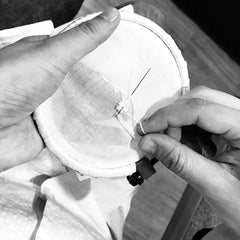The history of the embroidery needle and the beauty it leaves behind is actually quite humble. The various stitches we see today started out as simple tools to tailor, mend, or reinforce clothing and home linens. These stitches helped develop sewing techniques for construction as well…and as those stitches were practiced and improved, the idea of decorative stitches to create art took hold. Embroidery became a version of folk art as most cultures and countries created a style of their own. These techniques were treasured and taught to younger generations to keep the craft going.
 Examples of this popular decorative stitch have been found as early as the Warring States period in China, dating back to the 5th-3rd century BC. Depending on the time, location and materials available, embroidery was controlled by a few experts or a wide-spread, popular technique. This flexibility led to a variety of styles, from elaborate to simple.
Examples of this popular decorative stitch have been found as early as the Warring States period in China, dating back to the 5th-3rd century BC. Depending on the time, location and materials available, embroidery was controlled by a few experts or a wide-spread, popular technique. This flexibility led to a variety of styles, from elaborate to simple.
Elaborately embroidered clothing, religious objects, and household items were often seen as a mark of wealth and status. In many cultures, embroidery was a skill marking a girl's path into womanhood as well as conveying rank and social standing.
The embroidery process changed drastically with the development of machine embroidery. The earliest transition to machines combined embroidery completed on machine looms with teams of women embroidering textiles by hand. This process first appeared in France in the mid-1800s. Embroidery completed only by machines quickly followed, bringing access to this art form to the masses.
Fabrics and yarns used in traditional embroidery varied from place to place. Wool, silk, and linen fabric and yarn have been used for thousands of years. Embroidery thread is also available in cotton, rayon, and novelty threads. Ribbon embroidery uses narrow ribbon in silk or silk/organza blend ribbon, most commonly to create floral motifs. Other materials can be incorporated into the design as well, such as pearls and beads.
At Strasburg Children, embroidery has always been an important detail in our designs. When our company was created in the late 80’s, we fell for the charm of embroidery being done in its original form…just two hands, a needle, and thread. And that’s how our embroidery continues to be created to this day…in the loving hands of our talented artisans. For us, the balance of using new technology to reach our customers combined with the old-world traditions of hand embroidery seems to be the best fit for us. We hope you appreciate that detail as much as we do.


